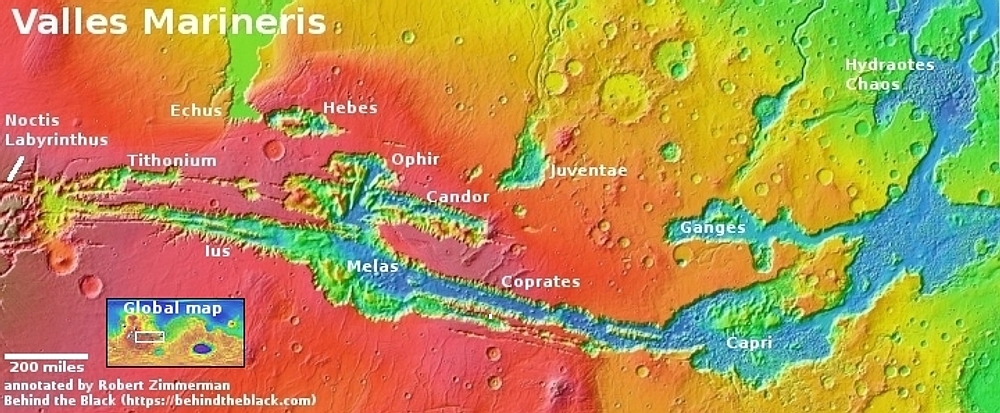A Martian glacier of dust
Cool image time! The picture above, rotated, reduced, and sharpened to post here, was taken on September 2, 2024 by the high resolution camera on Mars Reconnaissance Orbiter (MRO).
The tiny white dot near the lower center of the overview map below marks the location, on the northern wall of the smaller parallel canyon to the much larger part of Valles Marineris dubbed Coprates Canyon.
The scientists label this a “slope deposit.” What I see is a dust glacier flowing down hill in that long hollow (indicated by the arrows), with the ripple dunes actually acting almost like waves. Nor is this description unreasonable. On Mars the dust will gather in the hollows of these slopes and over time, with no rain and little wind to disturb them, will begin to flow down much like a glacier.
In this case, the descent is gigantic, considering the size of Valles Marineris. From the top to bottom of this image the elevation drop is about 14,000 feet over a distance of 11 miles.

On Christmas Eve 1968 three Americans became the first humans to visit another world. What they did to celebrate was unexpected and profound, and will be remembered throughout all human history. Genesis: the Story of Apollo 8, Robert Zimmerman's classic history of humanity's first journey to another world, tells that story, and it is now available as both an ebook and an audiobook, both with a foreword by Valerie Anders and a new introduction by Robert Zimmerman.
The print edition can be purchased at Amazon or from any other book seller. If you want an autographed copy the price is $60 for the hardback and $45 for the paperback, plus $8 shipping for each. Go here for purchasing details. The ebook is available everywhere for $5.99 (before discount) at amazon, or direct from my ebook publisher, ebookit. If you buy it from ebookit you don't support the big tech companies and the author gets a bigger cut much sooner.
The audiobook is also available at all these vendors, and is also free with a 30-day trial membership to Audible.
"Not simply about one mission, [Genesis] is also the history of America's quest for the moon... Zimmerman has done a masterful job of tying disparate events together into a solid account of one of America's greatest human triumphs."--San Antonio Express-News
Cool image time! The picture above, rotated, reduced, and sharpened to post here, was taken on September 2, 2024 by the high resolution camera on Mars Reconnaissance Orbiter (MRO).
The tiny white dot near the lower center of the overview map below marks the location, on the northern wall of the smaller parallel canyon to the much larger part of Valles Marineris dubbed Coprates Canyon.
The scientists label this a “slope deposit.” What I see is a dust glacier flowing down hill in that long hollow (indicated by the arrows), with the ripple dunes actually acting almost like waves. Nor is this description unreasonable. On Mars the dust will gather in the hollows of these slopes and over time, with no rain and little wind to disturb them, will begin to flow down much like a glacier.
In this case, the descent is gigantic, considering the size of Valles Marineris. From the top to bottom of this image the elevation drop is about 14,000 feet over a distance of 11 miles.

On Christmas Eve 1968 three Americans became the first humans to visit another world. What they did to celebrate was unexpected and profound, and will be remembered throughout all human history. Genesis: the Story of Apollo 8, Robert Zimmerman's classic history of humanity's first journey to another world, tells that story, and it is now available as both an ebook and an audiobook, both with a foreword by Valerie Anders and a new introduction by Robert Zimmerman.
The print edition can be purchased at Amazon or from any other book seller. If you want an autographed copy the price is $60 for the hardback and $45 for the paperback, plus $8 shipping for each. Go here for purchasing details. The ebook is available everywhere for $5.99 (before discount) at amazon, or direct from my ebook publisher, ebookit. If you buy it from ebookit you don't support the big tech companies and the author gets a bigger cut much sooner.
The audiobook is also available at all these vendors, and is also free with a 30-day trial membership to Audible.
"Not simply about one mission, [Genesis] is also the history of America's quest for the moon... Zimmerman has done a masterful job of tying disparate events together into a solid account of one of America's greatest human triumphs."--San Antonio Express-News



” . . . elevation drop is about 14,000 feet over a distance of 11 miles.”
That is impressive. Maui’s Haleakala Highway advertises as the world’s highest elevation gain in the shortest distance, and that’s ~10,000 feet over 37 miles.